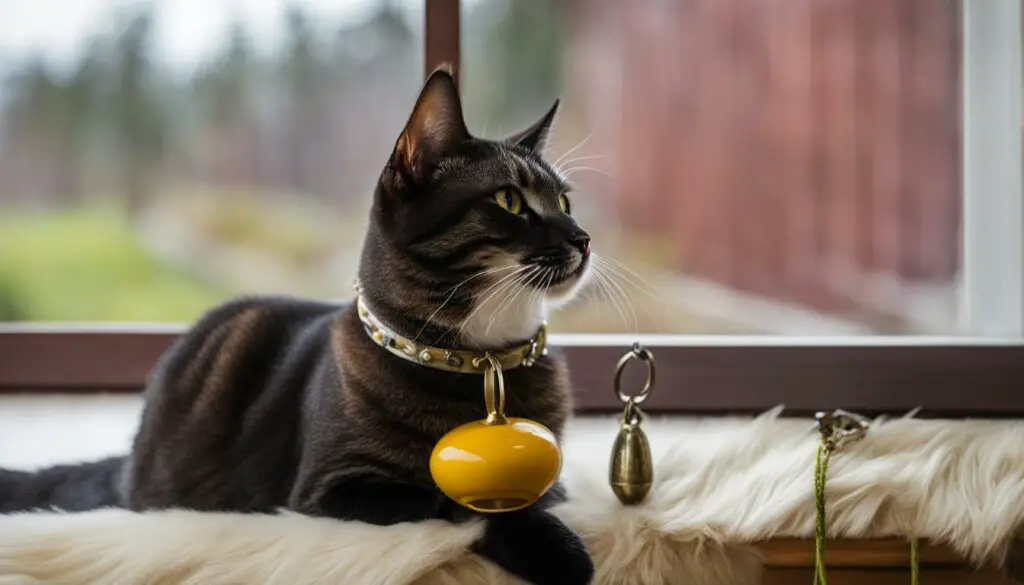As a cat owner, you may have wondered whether or not it’s necessary to put a collar on your indoor cat. While some people believe that indoor cats don’t need collars, there are several factors to consider before making a decision. Collars can provide identification and safety benefits, but they also come with potential drawbacks. In this article, I will discuss the pros and cons of collars for indoor cats and provide some tips on choosing the right collar and ensuring your cat’s safety.
Key Takeaways:
- Collars can help identify your indoor cat and hold an ID tag with your contact information.
- Collars without quick-release breakaway buckles can pose potential hazards if your cat gets caught.
- Choose a lightweight and comfortable collar made with natural materials for your indoor cat.
- Breakaway collars are essential to ensure your cat’s safety in case they get caught on something.
- There are alternative methods, such as microchipping, for identification and flea prevention.
The Benefits of Collars for Indoor Cats
Collars can provide several benefits for indoor cats. They can help identify your cat as belonging to a loving home and hold an ID tag with your contact information. This can be crucial in case your cat escapes and needs to be returned home. Furthermore, collars can also help your cat become comfortable with wearing a collar, which can be helpful if they ever need to wear one for medical reasons or special occasions. Additionally, some collars can provide flea treatment.
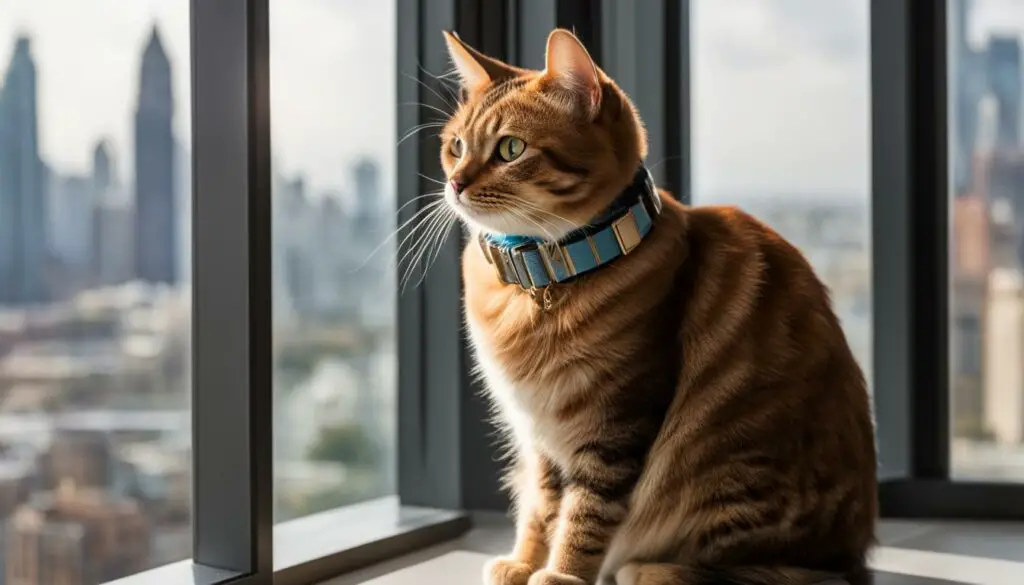
Collars can help identify your cat as belonging to a loving home and provide contact information in case of escape.
The Benefits of Collars for Indoor Cats
- Identification: Collars can help identify your cat as belonging to a loving home.
- Contact information: Collars can hold an ID tag with your contact information, making it easier for someone to return your cat if they wander off.
- Comfort with wearing a collar: Wearing a collar can be a beneficial experience for your cat, as it helps them become comfortable with wearing one for potential medical reasons or special occasions.
- Flea treatment: Some collars are designed to provide flea prevention and treatment for indoor cats.
Overall, collars can offer various benefits for indoor cats, providing identification, comfort, and potential flea prevention. However, it’s important to choose a collar that is safe, lightweight, and comfortable for your cat to wear. In the next section, we will discuss the potential drawbacks of collars for indoor cats and how to choose the right collar for your feline friend.
The Drawbacks of Collars for Indoor Cats
While there are benefits to putting a collar on an indoor cat, it’s important to consider the drawbacks as well. Collars without quick-release breakaway buckles can pose a potential hazard if your cat gets caught on something, which could lead to injury or strangulation. It’s important to choose a collar that is safe and comfortable for your cat to wear.
When considering the drawbacks of collars for indoor cats, the primary concern is the potential hazards they can pose. Collars that do not have quick-release breakaway buckles can become a danger if your cat gets caught on furniture, plants, or other objects in your home. This can lead to injury or strangulation, which is a significant risk for indoor cats who may not have the same outdoor survival skills as their outdoor counterparts.
It’s crucial to prioritize your cat’s safety when choosing a collar. Look for collars that have quick-release breakaway buckles, which will allow the collar to come undone if it becomes caught on something. This feature reduces the risk of injury or strangulation and provides peace of mind for cat owners.
| Drawbacks of Collars for Indoor Cats | Potential Hazards |
|---|---|
| Collars without quick-release breakaway buckles | Risk of injury or strangulation if caught on objects |
By considering the potential hazards and drawbacks of collars for indoor cats, you can make an informed decision about whether or not to use a collar for your feline companion. It’s important to weigh the benefits and drawbacks and choose a collar that prioritizes your cat’s safety and comfort. Remember to regularly check the fit and condition of the collar to ensure it remains secure and does not pose any risks to your indoor cat.
Choosing the Right Collar for Your Indoor Cat
When it comes to selecting a collar for your indoor cat, it’s essential to prioritize their comfort and safety. The right collar should be lightweight and comfortable, ensuring that your furry friend can wear it without any distress. Opt for collars made with soft, natural materials that won’t irritate your cat’s delicate skin. By choosing a collar that your cat feels comfortable wearing, you can ensure their well-being and peace of mind.
One important consideration when selecting a collar is its weight. Bulky or heavy collars can cause discomfort and potential neck strain for your cat. Lighter collars, on the other hand, allow for freedom of movement and reduce the risk of irritation or injury. Look for collars specifically designed for indoor cats, as they are often lighter and more comfortable compared to collars intended for outdoor use.
Comfort is another crucial aspect to consider. Cats are sensitive creatures, and a collar that isn’t comfortable can lead to stress or anxiety. Choose a collar with adjustable sizing to ensure a snug but not too tight fit. A collar that is too loose may slip off, while one that is too tight can be uncomfortable and restrict your cat’s movement. Regularly check and adjust the collar as needed to ensure it remains comfortable for your cat.
Table: Comparison of Lightweight and Comfortable Collars for Indoor Cats
| Collar Material | Weight | Comfort Level |
|---|---|---|
| Nylon | Lightweight | High |
| Soft Leather | Lightweight | High |
| Cotton | Lightweight | Medium |
| Velvet | Lightweight | Medium |
Remember, the collar you choose for your indoor cat should prioritize their well-being and comfort. By selecting a lightweight and comfortable collar made with soft, natural materials, you can ensure that your feline companion stays safe and stylish.
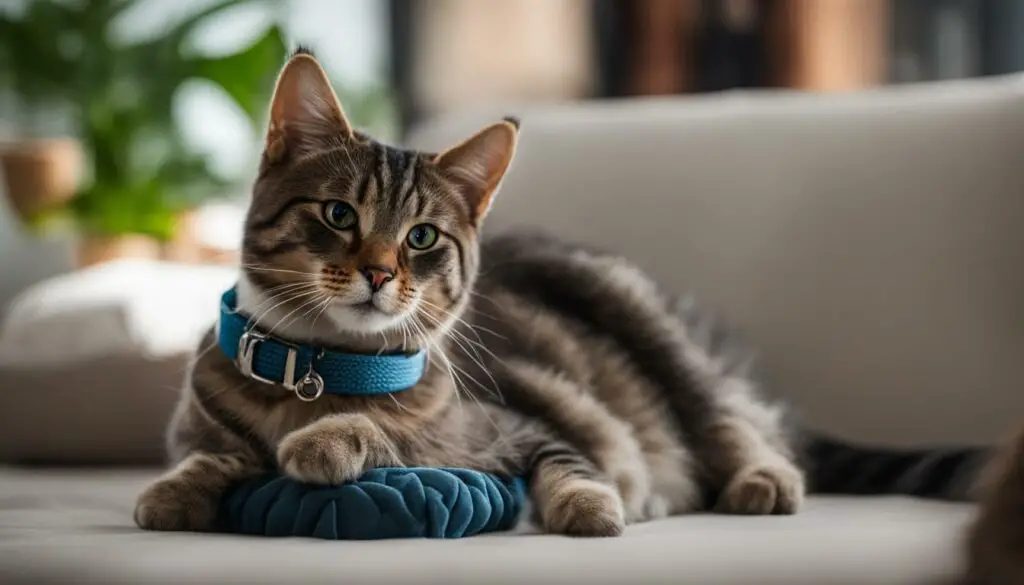
The Importance of Breakaway Collars for Indoor Cats
When it comes to the safety of our beloved indoor cats, choosing the right collar is of utmost importance. One type of collar that stands out for its safety features is the breakaway collar. These collars are specifically designed with a release mechanism that allows the collar to come undone if it gets caught on something. This is crucial for both adult cats and kittens, as even at home, accidents can happen.
An indoor cat may get their collar snagged or caught while playing, exploring, or simply being curious. Without a breakaway collar, they could potentially get injured or even strangled. By using a breakaway collar, we can give our feline friends the freedom to explore their surroundings without the risk of harm. It provides us with peace of mind knowing that even if they do get caught, they can easily free themselves and stay safe.
Breakaway collars are a simple but effective safety measure for indoor cats. They are lightweight and comfortable to wear, ensuring that our furry companions are not bothered by them. Whether it’s during playtime or when they’re lounging around the house, breakaway collars provide the necessary protection without causing any discomfort.
| Benefits of Breakaway Collars | Drawbacks of Breakaway Collars |
|---|---|
|
|
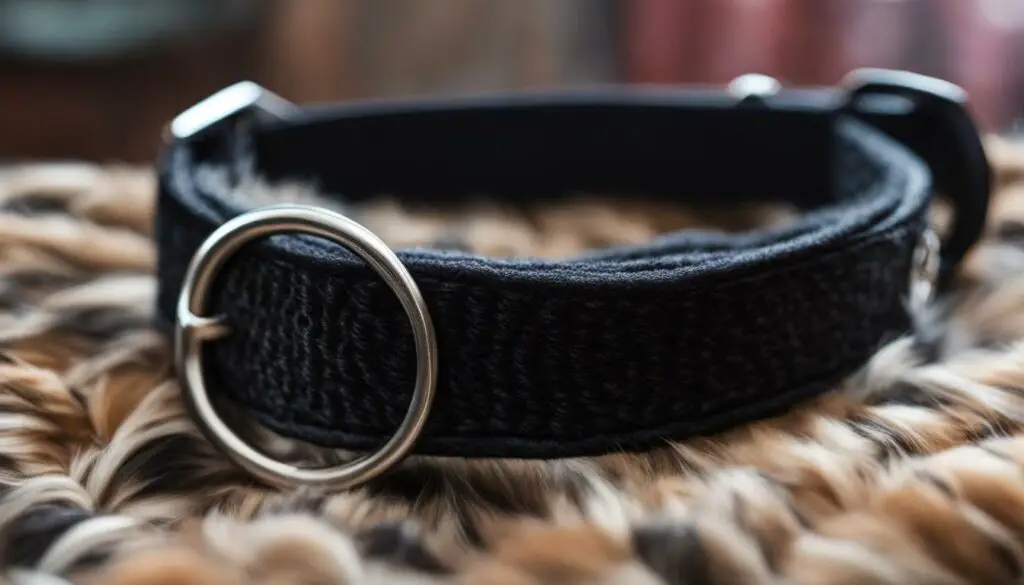
In conclusion, breakaway collars are an essential accessory for the safety of indoor cats. They provide the freedom for cats to explore their environment while minimizing the risk of accidents or injuries. By choosing a breakaway collar, we prioritize the well-being of our feline companions and ensure that they can navigate their surroundings with peace of mind.
How to Safely Put a Collar on Your Indoor Cat
Ensuring the safety of your indoor cat is paramount when it comes to putting a collar on them. Here are some steps to safely introduce and secure a collar on your feline friend:
- Allow your cat to become familiar with the collar: Before attempting to put the collar on your cat, give them the opportunity to explore and sniff it. This helps them get accustomed to the new object.
- Gradually introduce the collar: Start by loosely placing the collar around your cat’s neck without fastening it. This allows them to experience the sensation of wearing a collar without feeling restrained. Repeat this step multiple times until your cat appears comfortable with the collar.
- Secure the collar properly: Once your cat is comfortable with the collar, fasten it securely around their neck. Ensure that the collar fits snugly but not too tight, allowing for two fingers to fit between the collar and your cat’s neck. This prevents discomfort or injury.
- Monitor your cat’s behavior: After putting on the collar, observe your cat’s behavior for any signs of distress or discomfort. If your cat shows signs of distress, such as excessive scratching or attempts to remove the collar, it may be necessary to adjust the fit or consult with a veterinarian for guidance.
Remember, patience is key when introducing a collar to your cat. Make the process positive and rewarding by offering treats and praise. This helps create a positive association with wearing a collar and ensures a stress-free experience for your indoor cat.
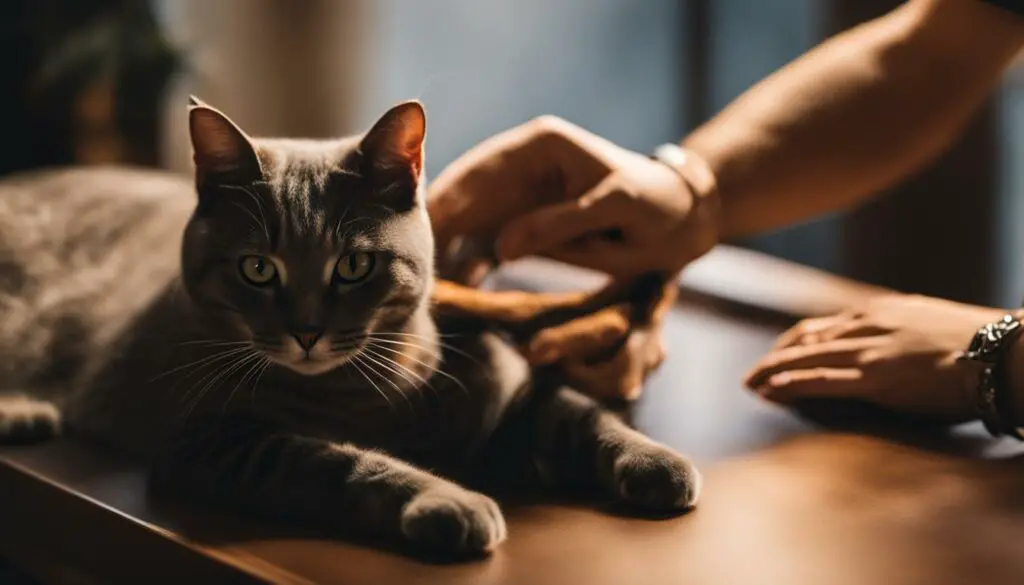
Expert Tip:
For added safety, consider using a breakaway collar for your indoor cat. Breakaway collars are designed to release and come undone if your cat gets caught on something, reducing the risk of injury or strangulation. They provide an extra layer of protection, even in the safety of your home.
Keeping Indoor Cats Safe Without Collars
While collars can be beneficial for indoor cats, there are other ways to keep them safe without relying solely on collars. It’s important to ensure that windows and doors are secure and do not provide opportunities for escape. Installing screens on windows can allow fresh air in while preventing cats from venturing outside. Training your cat to avoid door dashing can also help prevent accidental escapes. Additionally, microchipping your cat and keeping their information up to date can be crucial in case they do manage to escape.
Securing Windows and Doors
- Install secure screens on windows to prevent cats from escaping while still allowing fresh air into the house.
- Check windows and doors regularly for any gaps or openings that may provide an opportunity for your cat to escape.
- Consider using window restrictors or adjustable window stops to limit how far windows can open, ensuring your cat cannot squeeze through.
Preventing Door Dashing
- Train your cat to stay away from open doors by providing positive reinforcement for staying indoors.
- Use baby gates or pet barriers to create a designated safe area for your cat away from the front door.
- Consider using deterrents, such as motion-activated alarms or sprays, near doors to discourage cats from approaching them.
Microchipping and Keeping Information Up to Date
Microchipping your cat is a reliable method of identification in case they manage to escape without a collar. A microchip is a small device implanted under the skin that contains a unique identification number. If your cat is found and taken to a shelter or veterinary clinic, they can scan the microchip and retrieve your contact information from a database. It’s essential to keep your contact information up to date to ensure a quick reunion if your cat goes missing.
Remember, while collars can provide identification benefits, they should not be the sole method of keeping your indoor cat safe. By securing windows and doors, preventing door dashing, and microchipping your cat, you can provide additional layers of protection and increase the chances of a safe return if your cat ever escapes.
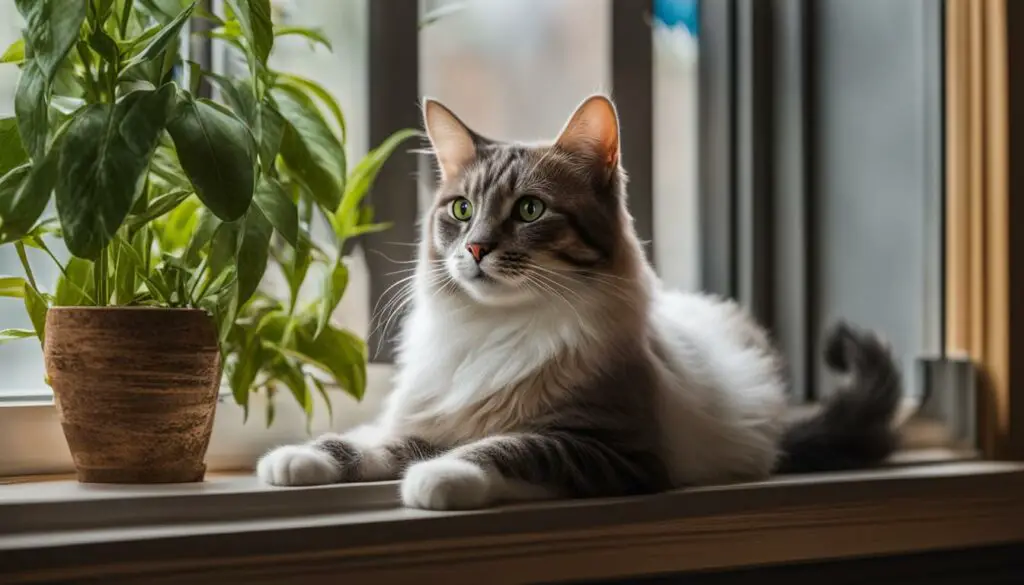
What to Do If Your Indoor Cat Escapes
If your indoor cat manages to escape, it can be a stressful and worrisome experience. Here are some steps you can take to increase the chances of finding your lost cat:
- Search the immediate area: Begin your search by thoroughly checking your surroundings. Look in nearby garages, sheds, and under decks or porches. Cats often hide in close proximity to where they escaped from.
- Call out to your cat: Use a calm and soothing voice to call your cat by name. Cats have excellent hearing and may respond to your familiar voice.
- Leave a scent trail: Place an item with your home’s scent, such as a blanket or your dirty laundry, near your home or in your yard. The familiar smell may attract your cat back.
- Use online resources: Post a picture and contact information on local community social pages or lost pet websites. This can help spread the word about your missing cat and increase the chances of someone recognizing and contacting you if they find your cat.
- Reach out to local vets and shelters: Contact nearby veterinary clinics and animal shelters to inform them about your lost cat. Provide a description and any identifying features of your cat. They may have received reports of found cats matching your description.
“Losing a pet can be a distressing experience, but it’s important to stay calm and take immediate action. By following these steps and utilizing available resources, you can increase the chances of finding your indoor cat and bringing them back home safely.”
– [Your Name]

When Collars Shouldn’t Be Used for Cats
While collars can provide identification and safety benefits for cats, there are certain situations where they should not be used. One such instance is when a cat is receiving medical treatment that involves the back of the neck. Collars may interfere with the treatment or cause discomfort to the cat. It’s important to follow the guidance of a medical professional in these cases.
Another scenario where collars may not be recommended is when a cat requires specific treatment, such as flea prevention, that is administered directly to the skin. Applying a collar on the same area can interfere with the effectiveness of the treatment. It’s crucial to prioritize the cat’s health and well-being by avoiding any potential conflicts between collars and medical treatments.
| Medical Reasons | Treatment Type |
|---|---|
| Involves back of the neck | Should not use collars |
| Requires direct skin application | Collars may interfere with treatment |
If you’re unsure whether or not to use a collar for your cat due to medical reasons, it’s always best to consult with a veterinarian. They can provide expert advice based on your cat’s specific condition and treatment plan. Remember, the health and safety of your cat should always be the top priority, and collars should never compromise their well-being.
Note: Always consult with a medical professional regarding your cat’s collar usage in cases involving medical treatment.
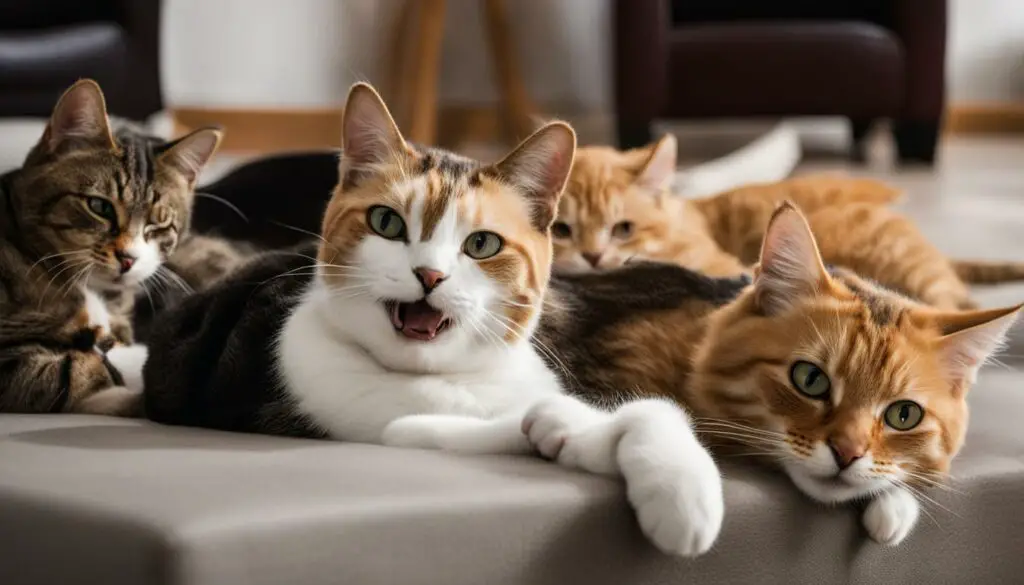
Leaving Collars on Cats All the Time
When it comes to leaving collars on cats all the time, there are important considerations to keep in mind. Generally, it is safe to leave collars on cats as long as they are fitted correctly and do not cause discomfort or pose a risk of injury. Collars can provide identification and safety benefits, especially for indoor cats that may accidentally escape. However, there are instances when the collar may need to be temporarily removed, such as during or following flea treatment.
It is essential to choose a collar that is safe and comfortable for your cat. Opt for lightweight collars made with natural materials that do not cause irritation. Ensure that the collar fits snugly but not too tight to prevent any potential hazards. Additionally, consider using breakaway collars that have a release mechanism, allowing the collar to come undone if it gets caught on something. This ensures that your cat can free themselves without getting injured.
If you have concerns or specific considerations regarding collar usage for your cat, it is always best to consult with your veterinarian. They can provide personalized guidance based on your cat’s needs and circumstances. By prioritizing your cat’s safety and well-being, you can make an informed decision about whether to leave a collar on them all the time.
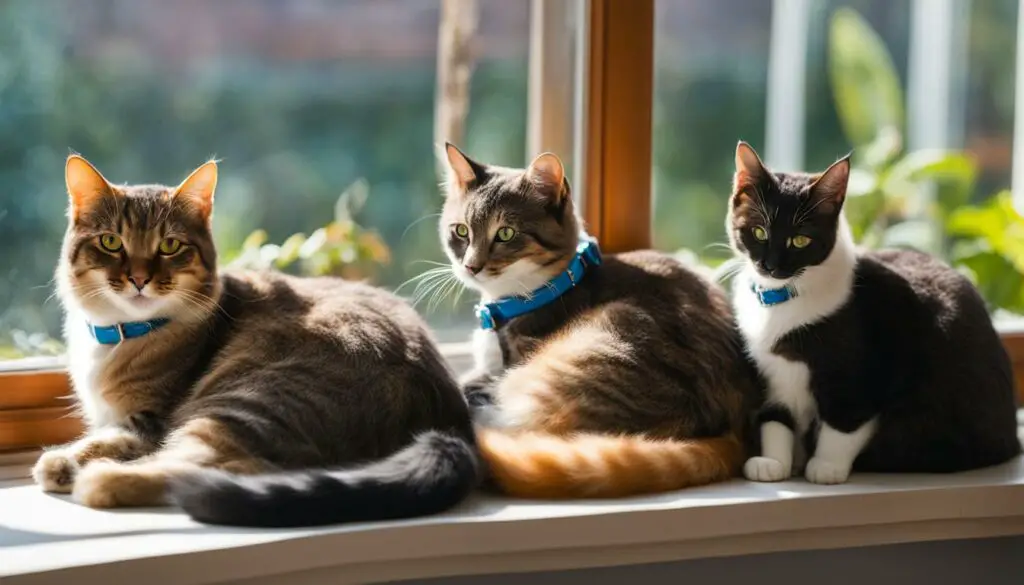
| Pros of Leaving Collars on Cats All the Time | Cons of Leaving Collars on Cats All the Time |
|---|---|
|
|
Cats and Collar Comfort
When it comes to cats and collar comfort, it’s important to understand that while some cats may initially find wearing a collar strange or unfamiliar, they often adjust and become comfortable with it over time. Giving your cat an adjustment period and positive reinforcement can help them get used to wearing a collar.
Start by introducing the collar gradually. Allow your cat to explore and sniff the collar to familiarize themselves with it. Practice putting the collar around their neck without fastening it, gradually increasing the duration they wear it. It’s important to make sure the collar fits snugly but not too tight, ensuring their comfort and safety.
While some cats may resist wearing a collar, it’s essential to prioritize their safety. A well-fitted collar can provide identification and help your cat find their way back home if they ever go missing. It’s important to choose a collar that is lightweight, comfortable, and appropriate for your cat’s size and breed.
Remember, each cat is unique, and their comfort with wearing a collar may vary. If you have concerns or your cat continues to resist wearing a collar, consult with your veterinarian for guidance and alternative identification options.
Table: Choosing a Comfortable Collar for Your Cat
| Features | Benefits |
|---|---|
| Lightweight and soft materials | Ensures comfort and reduces irritation |
| Adjustable sizing | Allows for a secure fit and prevents discomfort |
| Breakaway buckle | Ensures safety by allowing the collar to come undone if caught |
| Reflective or glow-in-the-dark features | Improves visibility during low-light conditions |
| Removable bells | Provides a warning sound to prevent hunting and protects wildlife |
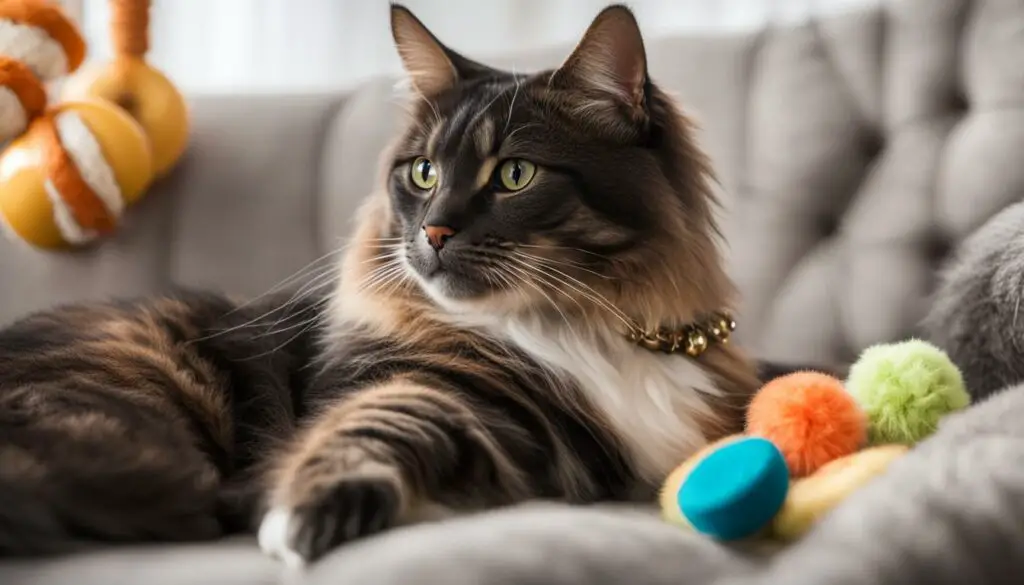
Remember to regularly check your cat’s collar for any signs of wear and tear. Replace the collar if it becomes damaged or worn out. With patience and proper selection, your cat can have a comfortable and safe collar-wearing experience.
Flea Collars for Indoor Cats
When it comes to protecting indoor cats from fleas, flea collars can be a convenient and effective option. While the risk of fleas may be lower for indoor cats, it’s important to remember that these pests can still be introduced into the home by humans or other pets that have access to the outdoors. Using a flea collar can provide an extra layer of protection against these pesky parasites and help ensure the well-being of your beloved feline friend.
Flea collars work by releasing chemicals that repel and kill fleas, ticks, and other common pests that can cause discomfort, irritation, and even transmit diseases. These collars typically contain active ingredients like imidacloprid, flumethrin, or deltamethrin, which are effective at repelling and killing fleas and ticks. It’s important to choose a flea collar that is specifically designed for cats and follow the manufacturer’s instructions for proper usage and duration of effectiveness.
By using a flea collar for your indoor cat, you can provide continuous protection against fleas, helping to prevent infestations in your home. It’s important to note that regular flea monitoring and prevention is still necessary, even for indoor cats. This can include regular grooming, vacuuming, and treating your cat’s bedding and living areas. Additionally, consult with your veterinarian to determine the most suitable flea prevention method for your indoor cat’s specific needs, as they may recommend alternative treatments or additional preventive measures.
The Role of Microchips and Collars for Cats
When it comes to ensuring the safety and identification of our feline friends, microchips and collars play important roles. Microchipping your cat provides a permanent form of identification that can greatly increase the chances of being reunited if they become lost. On the other hand, collars with ID tags offer a visual representation that your cat has a home and can provide immediate contact information to anyone who finds them. So, let’s explore the benefits of these two methods and why it’s recommended to have both microchips and collars for added security.
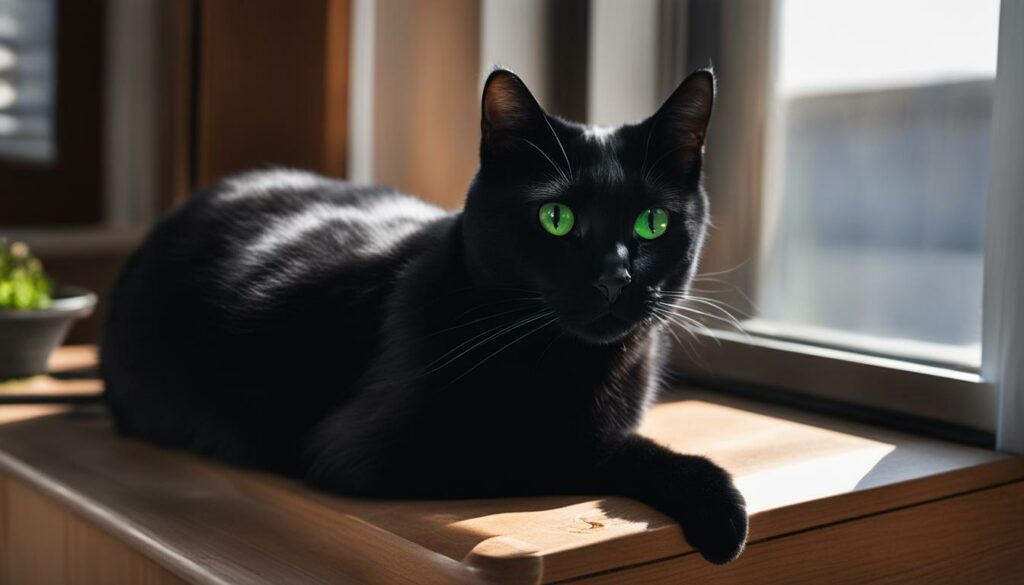
Microchipping involves inserting a small chip, about the size of a grain of rice, under your cat’s skin. This chip contains a unique identification number that can be scanned by animal shelters, veterinarians, and other professionals to access your contact information in a secure database. It’s a reliable and permanent form of identification that cannot be lost or removed, providing peace of mind for pet owners. However, it’s important to remember that the microchip is not visible to the naked eye, so it’s essential to have a collar with an ID tag as a visible form of identification.
Collars with ID tags offer immediate identification for your cat. These tags typically include your cat’s name and your contact information, making it easier for someone to reach out if they find your lost cat. The visual representation of a collar can also indicate that your cat belongs to a loving home and is not a stray. Additionally, collars can be customized with various designs and colors, allowing you to showcase your cat’s personality while providing a functional purpose.
By combining a microchip and a collar with an ID tag, you provide your cat with both a permanent and visible form of identification. In the event that your cat goes missing, having both methods increases the chances of a successful reunion. Remember to keep your contact information up to date and ensure that your cat’s collar is securely fastened but not too tight, allowing for comfort and safety. By taking these precautions, you can ensure that your beloved feline friend can be easily identified and returned home if they ever become lost.
Making an Informed Decision About Collars
When it comes to deciding whether or not to put a collar on your indoor cat, there are a few key factors to consider. Collars can provide identification and safety benefits, but it’s important to weigh these against your cat’s specific needs and circumstances. Consider the following factors before making a decision:
Feline behavior and comfort:
Some cats may feel uncomfortable or stressed when wearing a collar, while others may be indifferent. It’s important to consider your cat’s behavior and comfort level before deciding to put a collar on them. Start by introducing the collar gradually, allowing your cat to become familiar with it over time. Monitor their behavior and make adjustments as needed to ensure they are comfortable.
Risk of escape:
Indoor cats are generally at a lower risk of escaping compared to outdoor cats. However, accidents can happen, and collars can provide a form of identification in case your cat does manage to get outside. Evaluate your home environment and assess the risk of escape before deciding whether or not to use a collar.
Alternative identification methods:
While collars can be effective in providing immediate identification, microchipping is a more permanent and reliable form of identification. Microchips are small chips implanted under the skin that contain your contact information. Consider microchipping your cat as an alternative or in addition to using a collar, ensuring that their identification is always up to date.
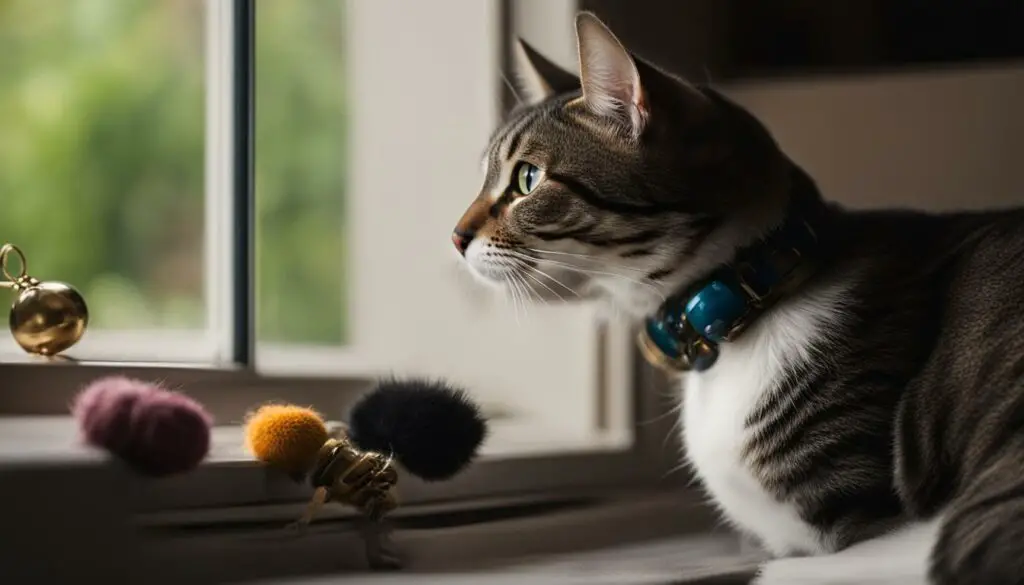
Consult your veterinarian:
When making a decision about collars for your indoor cat, it’s always best to consult with your veterinarian. They can provide valuable insight and guidance based on your cat’s specific needs and circumstances. Your vet can help you choose a collar that fits properly and is safe for your cat to wear.
| Benefits of Collars for Indoor Cats | Drawbacks of Collars for Indoor Cats |
|---|---|
|
|
Remember, the decision to put a collar on your indoor cat ultimately depends on your cat’s individual needs and circumstances. By considering their behavior, the risk of escape, and alternative identification methods, you can make an informed decision that prioritizes their safety and comfort.
Alternatives to Collars for Indoor Cats
While collars can be beneficial for indoor cats, there are alternative options to consider for identification and prevention. One alternative is microchipping, which provides permanent identification for your cat. A small microchip is inserted under the cat’s skin, containing a unique ID number that can be scanned by veterinarians or animal shelters. Microchipping is a reliable method to ensure your cat can be identified and reunited with you if they ever get lost. It is often recommended by veterinary professionals as a more secure form of identification compared to collars.
“Microchipping provides a permanent form of identification for indoor cats, eliminating the risk of losing identification tags that may fall off collars. It gives pet owners peace of mind, knowing that their beloved cat can be easily identified if they end up in a shelter or veterinary clinic,” says Dr. Emily Johnson, a veterinarian specializing in feline medicine.
Another alternative to collars is the use of preventive measures that don’t require physical identification. Indoor cats are at a lower risk of escaping or getting lost, so you may opt for preventive measures such as secure windows, doors, and screened-in areas to prevent accidental escapes. Additionally, you can keep your cat indoors at all times and provide them with a safe and enriching environment that minimizes the need for additional identification measures.
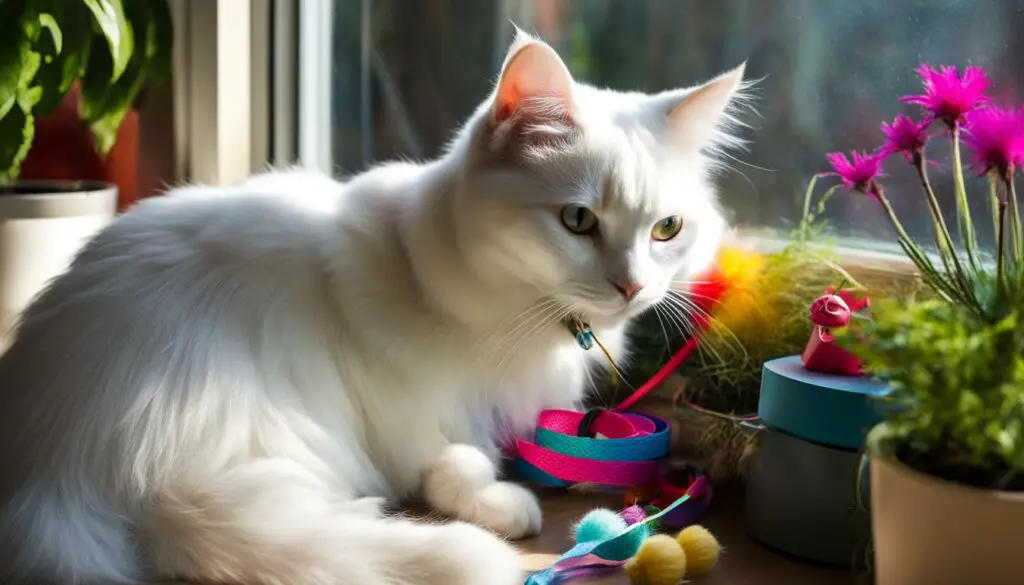
Ultimately, the decision to use collars or explore alternatives depends on your cat’s specific needs and your personal preferences. It’s important to prioritize your cat’s safety while considering the most effective method of identification and prevention for your indoor feline companion.
Conclusion
After carefully considering the benefits, drawbacks, and alternatives, I believe that the decision to put a collar on your indoor cat should be based on their specific needs and circumstances. Collars can provide identification and safety benefits, allowing your cat to be easily recognized as a beloved pet and ensuring their safe return if they accidentally escape. However, it’s crucial to choose a collar that is safe and comfortable for your cat, such as a lightweight and breakaway design.
While collars can be beneficial, there are alternatives to consider for indoor cats. Microchipping is a permanent form of identification recommended by veterinary professionals, providing an additional layer of security. Additionally, there are alternative methods for flea prevention that may be more effective and safer than flea collars. It’s important to explore these options and consult with your vet to determine the best approach for your cat’s individual needs.
Ultimately, the safety of your indoor cat should always be the top priority. Whether you choose to use a collar, rely on microchipping, or explore alternative methods, make an informed decision that aligns with your cat’s comfort and your peace of mind. Remember to regularly check your cat’s collar for any signs of wear or discomfort, and never leave a collar on if advised against it by a medical professional or during specific treatments. By prioritizing their safety, you can ensure that your indoor cat remains happy and healthy in their loving home.
FAQ
Should indoor cats wear collars?
While the decision is ultimately up to the owner, there are benefits to putting collars on indoor cats such as identification and safety. However, there are also potential hazards to consider.
What are the benefits of collars for indoor cats?
Collars can help identify indoor cats as belonging to a loving home and hold an ID tag with contact information. They can also help cats become comfortable with collar wearing and provide flea treatment.
What are the drawbacks of collars for indoor cats?
Collars without quick-release breakaway buckles can be potential hazards if a cat gets caught on something, leading to injury or strangulation.
How do I choose the right collar for my indoor cat?
It’s important to choose a collar that is lightweight, comfortable, and made with natural materials. Avoid bulky or heavy collars that may cause discomfort or irritation.
Why are breakaway collars important for indoor cats?
Breakaway collars have a release mechanism that allows them to come undone if a cat gets caught on something, ensuring their safety and preventing injury or strangulation.
How can I safely put a collar on my indoor cat?
Allow your cat to become familiar with the collar first, gradually introducing it by practicing putting it around their neck without fastening it. Once they are comfortable, fasten the collar securely but not too tight.
How can I keep my indoor cat safe without using a collar?
Ensure windows and doors are secure, install screens on windows, train your cat to avoid door dashing, and consider microchipping as a permanent form of identification.
What should I do if my indoor cat escapes?
Immediately check the surrounding area, call their name calmly, leave something with your home’s scent outside, post on community social pages or put up posters, and contact local vets and shelters.
Are there instances when collars shouldn’t be used for cats?
If advised by a medical professional or if a cat is receiving back of the neck treatment, such as flea treatment, it’s best to avoid putting a collar on them.
Can I leave collars on cats all the time?
Generally, as long as the collar is fitted correctly and does not cause discomfort or pose a risk of injury, it is safe to leave collars on cats all the time. However, there may be instances when the collar needs to be temporarily removed.
How do cats adjust to wearing collars?
Initially, cats may find wearing a collar strange or unfamiliar, but with time, most cats adjust and become comfortable. Giving them an adjustment period and positive reinforcement can help ease the transition.
Can indoor cats wear flea collars?
Indoor cats can wear flea collars to protect against fleas, but it’s important to consult with a vet to determine the most suitable flea prevention method for your cat.
What is the role of microchips and collars for cats?
Microchips provide permanent identification, while collars with ID tags serve as immediate visual representation of a cat’s home. It’s recommended to have both for added security.
How can I make an informed decision about collars for my indoor cat?
Consider the benefits, drawbacks, and alternatives, and consult with a vet to determine what suits your cat’s specific needs and circumstances.
What are the alternatives to collars for indoor cats?
Alternatives include microchipping for identification and other methods for flea prevention. Explore these options and consult with a vet to determine the best alternatives for your cat.

